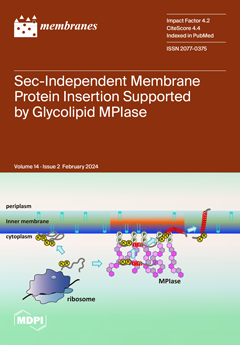In this study, the hybrid biological ion exchange (BIEX) resin and gravity-driven membrane (GDM) process was employed for the treatment of coloured and turbid river water. The primary objective was to investigate the impact of both physical and chemical cleaning methods on ceramic
[...] Read more.
In this study, the hybrid biological ion exchange (BIEX) resin and gravity-driven membrane (GDM) process was employed for the treatment of coloured and turbid river water. The primary objective was to investigate the impact of both physical and chemical cleaning methods on ceramic and polymeric membranes in terms of their stabilised flux, flux recovery after physical/chemical cleaning, and permeate quality. To address these objectives, two types of MF and UF membranes were utilised (M1 = polymeric MF, M2 = polymeric UF, M3 = ceramic UF, and M4 = lab-made ceramic MF). Throughout the extended operation, the resin functioned initially in the primary ion exchange (IEX) region (NOM displacement with pre-charged chloride) and progressed to a secondary IEX stage (NOM displacement with bicarbonate and sulphate), while membrane flux remained stable. Subsequently, physical cleaning involved air/water backwash with two different flows and pressures, and chemical cleaning utilised NaOH at concentrations of 20 and 40 mM, as well as NaOCl at concentrations of 250 and 500 mg Cl
2/L. These processes were carried out to assess flux recovery and identify fouling reversibility. The results indicate an endpoint of 1728 bed volumes (BVs) for the primary IEX region, while the secondary IEX continued up to 6528 BV. At the end of the operation, DOC and UVA
254 removal in the effluent of the BIEX columns were 68% and 81%, respectively, compared to influent water. This was followed by 30% and 57% DOC and UVA
254 removal using M4 (ceramic MF). The stabilised flux remained approximately 3.8–5.2 LMH both before and after the cleaning process, suggesting that membrane materials do not play a pivotal role. The mean stabilised flux of polymeric membranes increased after cleaning, whereas that of the ceramics decreased. Enhanced air–water backwash flow and pressure resulted in an increased removal of hydraulic reversible fouling, which was identified as the dominant fouling type. Ceramic membranes exhibited a higher removal of reversible hydraulic fouling than polymeric membranes. Chemical cleaning had a low impact on flux recovery; therefore, we recommend solely employing physical cleaning.
Full article






